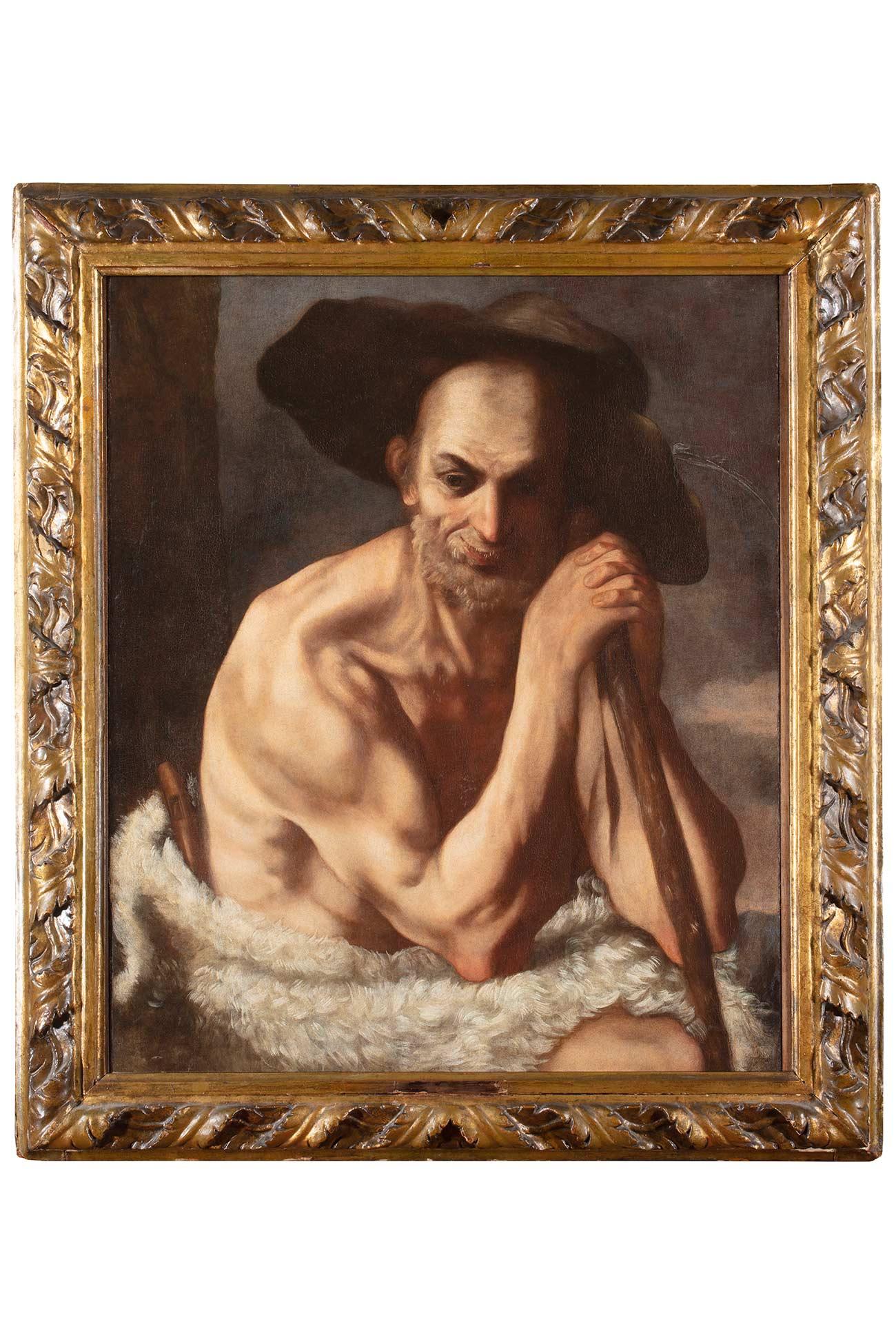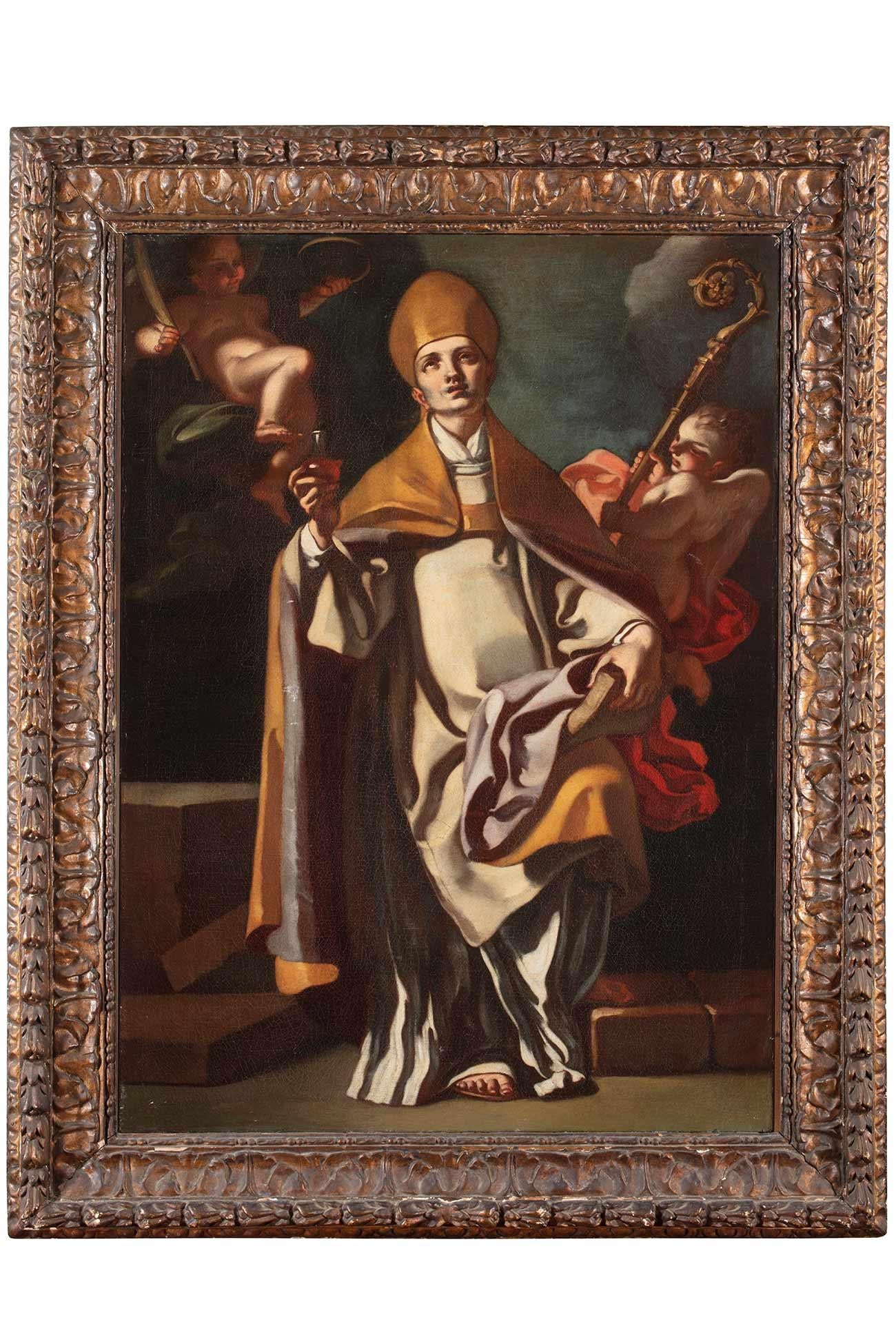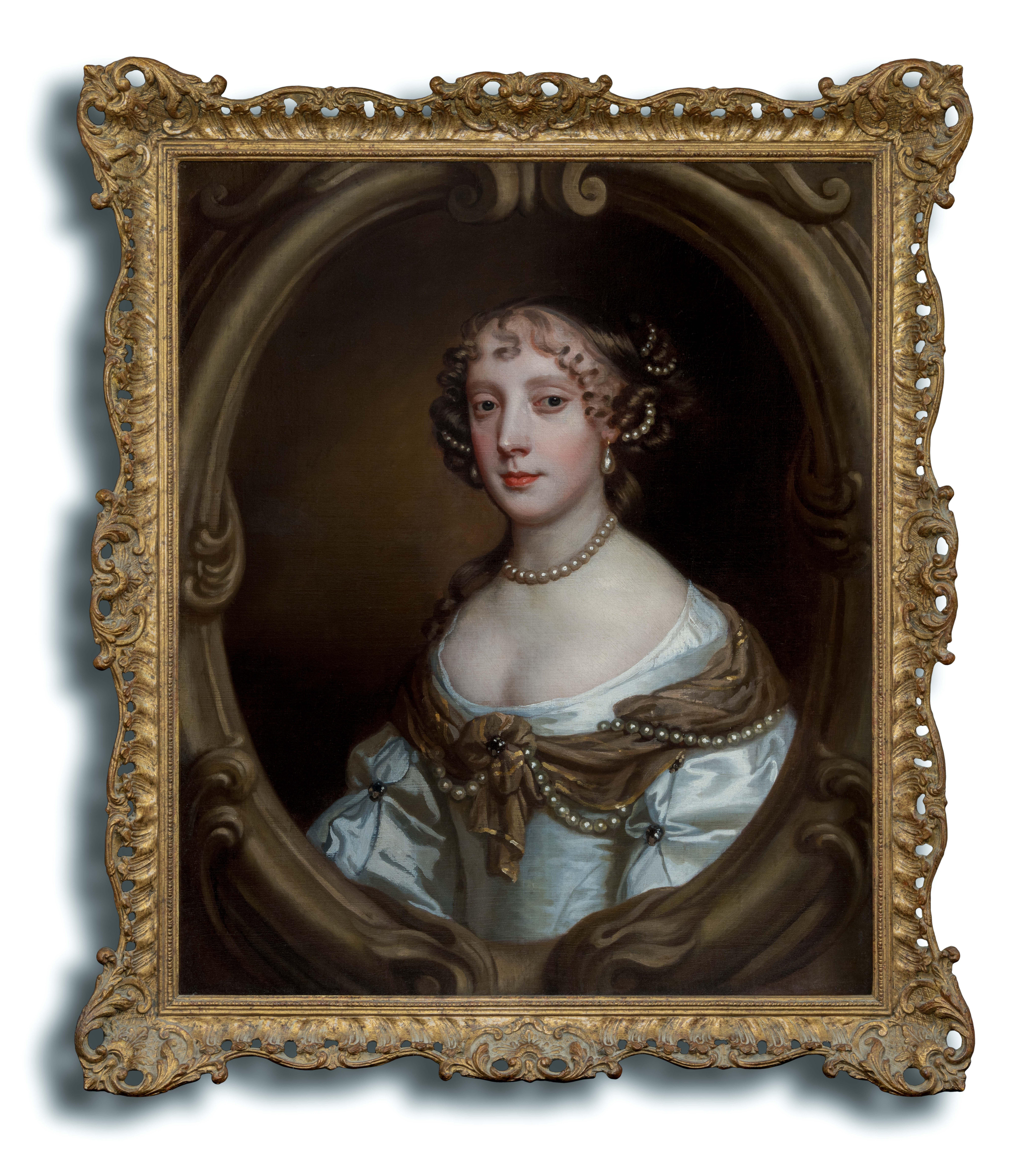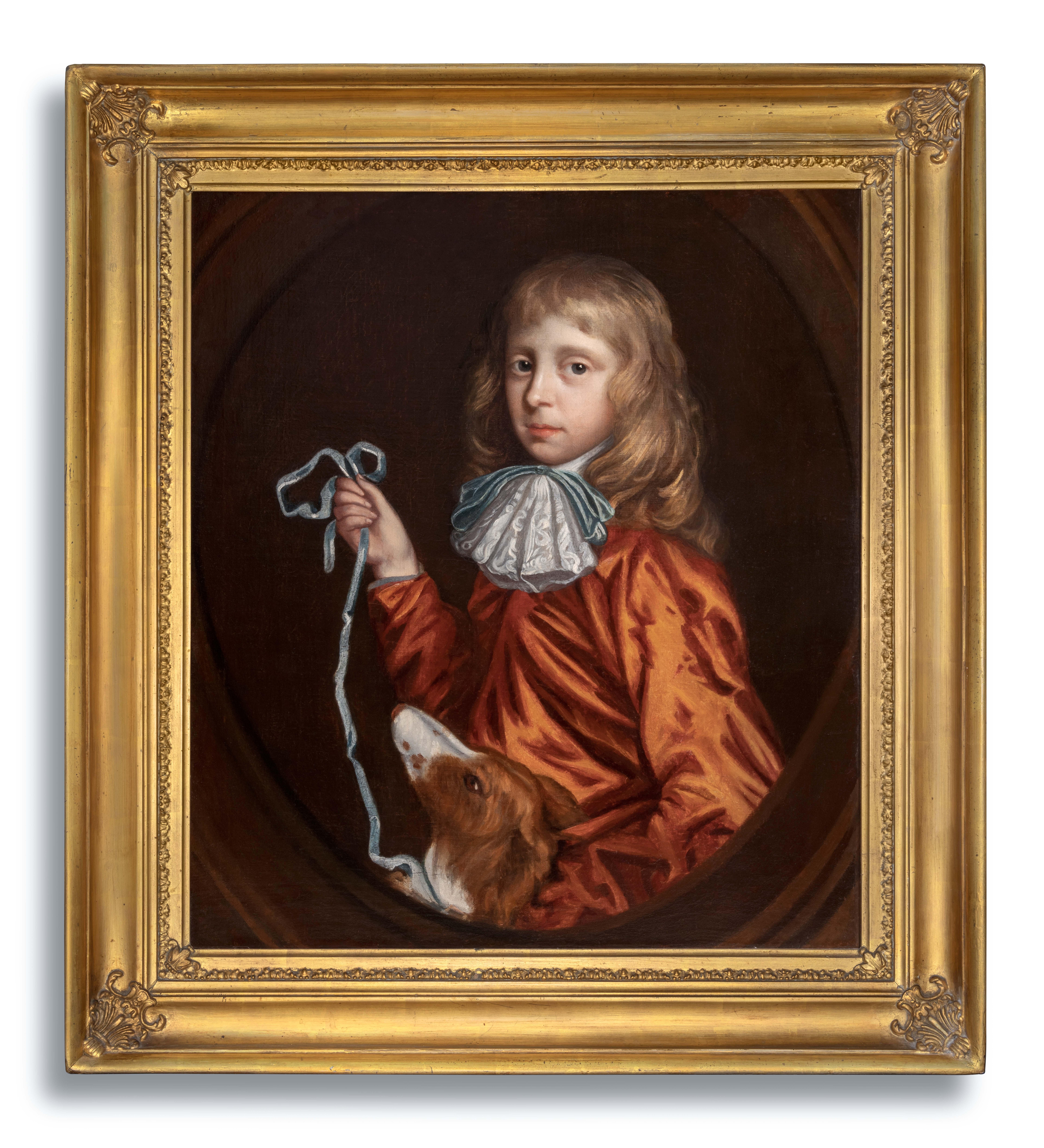Items Similar to Portrait of a Lady, Katherine St Aubyn, Godolphin, Cornelius Johnson, Oil canvas
Want more images or videos?
Request additional images or videos from the seller
1 of 13
Portrait of a Lady, Katherine St Aubyn, Godolphin, Cornelius Johnson, Oil canvascirca 1637
circa 1637
About the Item
Titan Fine Art are pleased to present this charming bust-length portrait, which is a good example of the style of portrait painted in England in the second quarter of the seventeenth century. The attire consists of the finest silks, and the full billowing sleeves, bows, and hairstyle help in dating this portrait to circa 1637. The accessory par excellence – pearls – are worn as a necklace and were a very popular accessory. The artist makes no attempt to obey the rules of Baroque and instead sensitively depicts in complete honesty his sitter against a plain wall, and without distracting backdrops and flowing draperies – this work is very redolent of the sumptuous half-length female portraits that Cornelius Johnson painted for members of the court and gentry during the 1630s.
The sitter is Katherine St Aubyn, born Katherine Godolphin (1620-1662). The Godolphin’s are an ancient Cornish family (originally “Godolghan” which in Cornish means “White Eagle”) who were established at their family seat, Godolphin Manor, since the time of the Norman Conquest in the year 1,000. The Manor descended from the first known lord, John de Godolphin, to Tudors times, from father to son, barring once in the 14th century.
Katherine was born in September 1620 and was the youngest daughter of Francis Godolphin (1589-1652), of Treveneage in Cornwall, and his wife Ann Carew. She married into another ancient family - the St. Aubyn’s, whose ancestors can be traced back in Devonshire to the 14th century. Her husband John St Aubyn (c.1613–1684) of Clowance and St Michael’s Mount, was a member of parliament and during the English Civil war he served as a colonel in the parliamentary army - unlike the senior branches of the Godolphin’s, who served as Royalists. The couple had six sons and four daughters. Katherine was buried at Crowan on 16 Mar 1662 when she was only 41 years of age. Her husband was also buried there, 22 years later.
The couple married on 29th March 1637. This date coincides with the date the portrait was painted, given that the attire and hairstyle were fashionable in 1637. It is very likely that the portrait was commissioned to mark this important event in the sitter’s life, as was customary at the time. Furthermore, the figure is turned toward the viewer’s left, which was usually the manner in which a married woman would be depicted in English portraiture at the time (the pendant portrait, her husband, would have been turned toward the viewer’s right).
Cornelius Johnson (1593-1664) through merit and splendid achievement, can be placed within the first rank of England’s portrait painters of the generation before Van Dyke. Cornelius Johnson was a painter beautifully sensitive to individual character and his careful and faithful depictions of clothing afford a priceless resource to historians – he was the first British-born portrait painter (born in London) to regularly sign and date his work. His precise, meticulous, and dignified portraits perfectly reflect the spirit of the arts in England at the time. So great a painter, he was sworn in as the King’s own painter in 1632. His work is found in most pubic collections in Britain and in many private collections – seen on the walls in many British country houses, in the possession of descendants of the original sitters.
Johnson was born into a Flemish/German immigrant family in 1593 in London. He is thought to have begun his independent practice in London, in about 1619. Where he trained it is not fully known as records are scant, but it is thought to be in Amsterdam. In addition, he may also have received some training in the London studio of Marcus Gheeraerts II (1561/2-1636), who was the official portraitist of James I’s queen, Anne of Denmark. As a result, even Johnson’s earliest pictures display a level of continental sophistication not often seen in the works of English Jacobean artists. And in a society that relished ‘conspicuous consumption’, and thus the display of expensive costumes, Johnson’s Dutch realism and sense of likeness proved popular. He became extremely prolific and he painted elegant images of the King, the Queen, and the whole court, many leading lawyers and public servants, but also a regional clientele away from the court primarily in Kent.
In 1632, the same year Van Dyck arrived in England, Johnson was appointed one of King Charles I’s painters. In late 1634 Johnson is recorded to have been living in London. By some accounts, Johnson moved to Kent around 1636 but this is not known for certain. What is certain is that from about the early 1630s onwards his clients included many sitters from a group of families living around Canterbury, Kent.
In 1643, just prior to the outbreak of the Civil Wars in Britain, Johnson and his family left for Holland where he worked in more than one city and was leading portrait painter in Utrecht, where he remained until his death. His only surviving son, called Cornelius, was born in London in 1634. He too was a painter and assisted his father.
There are three old labels on verso (see photos); two refer to London storage firms and the surname ‘Scrimageour’ (which may be J & A Scrimgeour, insurance brokers located at 3 Lothbury, London EC2).
Provenance: Private UK collection
Measurements: Height 82cm, Width 71cm framed (Height 32”, Width 28” framed)
- Creation Year:circa 1637
- Dimensions:Height: 32.29 in (82 cm)Width: 27.96 in (71 cm)Depth: 1.58 in (4 cm)
- Medium:
- Movement & Style:
- Circle Of:Cornelius Johnson (1593 - 1661, British)
- Period:
- Condition:This painting has passed a strict quality and condition assessment by a professional conservator prior to going on sale. It can be hung and enjoyed immediately.
- Gallery Location:London, GB
- Reference Number:1stDibs: LU1199110599512
About the Seller
5.0
Platinum Seller
These expertly vetted sellers are 1stDibs' most experienced sellers and are rated highest by our customers.
Established in 1998
1stDibs seller since 2019
31 sales on 1stDibs
Typical response time: <1 hour
- ShippingRetrieving quote...Ships From: London, United Kingdom
- Return PolicyA return for this item may be initiated within 14 days of delivery.
More From This SellerView All
- Portrait of Lady, Grace Saunderson, Viscountess Castleton Oil on canvas PaintingBy Studio of Sir Peter LelyLocated in London, GBPortrait of Grace Saunderson, Viscountess Castleton (1635-1667) c.1665-67 Sir Peter Lely and Studio (1618-1680) Titan Fine Art present this work, which formed part of a collection of family pictures and heirlooms of the Saunderson, Viscount Castleton family and their descendants, the Earls of Scarbrough, at their magnificent family seat Sandbeck Park, where the Earls still reside today almost four hundred years later. It was painted in the studio of Sir Peter Lely...Category
17th Century Old Masters Portrait Paintings
MaterialsCanvas, Oil
- Portrait of a Young Gentleman and Pet Dog c.1680, Antique oil on Canvas PaintingBy (Circle of) Mary BealeLocated in London, GBThe portrait genre was valued particularly highly in English society. Neither landscapes nor allegorical pictures were ever priced so highly at exhibitions and in the trade as depictions of people, from the highest aristocracy to scholars, writers, poets and statesmen. This charming portrait, presented by Titan Fine Art, of a fashionable young gentleman and his faithful pet is an excellent example of 17th century child portraiture in England. There is a remarkable beauty and sensitivity to the portrait. The face, particularly well rendered, has captured the character of this young man – both charming and at the same time mischievous. Only the playful attention of a small dog suggests anything less than patrician dignity. Symbolism was important in portraiture and it provided a pointed and aspirational narrative that would not have been lost on contemporary viewers. For example, the presence of the dog, which was likely the boy’s pet, is at once a charming pictorial device and also a clear allusion to fidelity, trust and loyalty. The hairstyle and the attire, notably the type of cravat with the blue ribbon, help to date this portrait to between 1670 to 1685. Until the late eighteenth century children were dressed as adults - boys were dressed like men in breeches, vests, and coats between four and seven years of age. The expensive lace is an indication to his family’s wealth. Held in a good quality and condition antique gilded frame. Born in Suffolk, Mary Beale, nee Cradock (1633-1699) was employed by many of the most distinguished persons of her time including nobility, landed gentry, and clergymen. Technically accomplished, her paintings are noteworthy for their honest and sympathetic portrayal. In 1651 she married Charles Beale...Category
17th Century Old Masters Portrait Paintings
MaterialsCanvas, Oil
- Portrait of Abigail, Countess of Kinnoull, Signed Dated Godfrey Kneller PaintingBy Kneller GodfreyLocated in London, GBPresented by Titan Fine Art, this elegant and beautiful portrait depicts Abigail Hay, Lady Dupplin, Countess of Kinnoull; it is an excellent example of English portraiture from the f...Category
18th Century Old Masters Portrait Paintings
MaterialsCanvas, Oil
- Double Portrait of Sir John Rivers 3rd Baronet of Chafford, and Lady Anne RiversLocated in London, GBThis magnificent grand-scale work, offered by Titan Fine Art, formed part of a collection of family pictures and heirlooms of the Rivers Baronets and their descendants for over 325 years, before it was dispersed by the last in the line in 1988. The work was painted by the most technically proficient painter in England after the death of Van Dyck, and the dominant court painter to Charles II and James, Duke of York, Sir Peter Lely. It is no surprise that for years Lely had no serious rivals, was enormously influential and successful, and one of the country’s most important painters – and his work influenced countless artists over generations. The exquisite carved and gilded auricular frame is an astounding work of art in itself. The sitters in this exquisite double portrait are Sir John Rivers, who succeeded as the 3rd Baronet Chafford in 1657 (c.1638 - c. 1679), and his wife, Lady Anne Hewitt (c.1640-c.1689). They are seated in an outdoor setting beside a fountain modelled as a female figure with water issuing into a scallop-shell. The water, the elaborate sculpted fountain with its scallop-edged bowl, and the open shell in her hand are symbols of fertility - as such they make an appropriate allusion to Lady Anne’s potential as wife and mother, recalling Proverbs, chapter 5, verse 18: “Let thye fountain be blessed, and rejoice in the wife of thye youth”. This reference was realised, as Sir John and Lady Anne produced at least six children; their son George (1665-1734) became 4th Baronet of Chafford. The composition, thus, represents a celebration of marriage and was likely commissioned around the time of the betrothal (the marriage took place 26th Feb 1662 or 1663). The statues in the left margin are 'Youth and 'Old Age' and are a typical form of Memento Mori reminding virile young man that even they will lose their youth and grow old. The Rivers family, originally of Kent, traces its history to Sir Bartholomew Rivers, in the reign of Edward IV. The family included several prominent members including several knights, a Commander in the King's Army, a steward of a ducal estate, a Lord-Mayor of London, and an M.P. John Rivers (c.1659-c.1651) was made 1st Baronet of Chafford in 1622 by King James I. The Chafford estate was the family seat and it remained so until the early 1700s with the death of Sir George Rivers, 4th Baronet (1665–1734), whose sons had all died. The Chafford estate was left to his daughters while the baronetcy passed to nephew John Rivers, 5th Baronet (c. 1718–1743), and then Sir John’s brother, Sir Peter Rivers-Gay, 6th Baronet (c. 1721–1790). Upon Sir Peter Rivers Gay's death the estate passed to his eldest son, Sir Thomas Rivers Gay, 7th Baronet (c. 1770–1805). Sir Thomas, dying in 1805 with no children, bequeathed the estate to his mother Dame Martha Rivers Gay, who managed the estate until 1834 when she settled it on the then Sir Henry Rivers, 9th Baronet (c. 1779–1851) her younger son, before dying shortly thereafter in 1835. Sir Henry had married in 1812 to Charlotte Eales, with whom he had 6 sons and 8 daughters. Upon his death in 1851 the estate passed to his eldest surviving son Sir James Francis Rivers, 10th Baronet (1822–1869). Sir James married Catherine Eastcott in 1867 but died childless in 1869, and the estate passed to his only surviving brother Sir Henry Chandos Rivers, 11th Baronet (1834–1870) but he died a year later in 1870 also childless; with no male heir the Baronetcy was therefore extinguished. The estate was bequeathed, in trust, by Sir Henry Chandos Rivers to Thomas Frederick Inman, a solicitor of Bath, who then managed the estate as a trustee on behalf of Sir Henry Chandos Rivers' sister Katherine Rivers (c.1826-1895). It then passed to Katherine River’s daughter, Katherine Wall (born c.1855), who had also inherited Worthy Park House from her father, George Alfred Ellis Wall (1825-1875). Until 1958 our portrait is known to have hung at Worthy Park House. Upon Katherine Wall’s death, the Rivers estate passed to her daughter, Katherine Eleonora Rivers Fryer (1889-1963), who married Colonel James Alexander Butchart 1877-1853. In 1958 the family sold Worthy Park House but our portrait was loaned to Southampton Museum and Art Gallery. After the death of Katherine and Colonel James, the estate was left to their only son, Charles Bruce Rivers Butchart (1917-2005) and upon Charles’ retirement to a nursing home in 1988, and without heirs, our portrait, along with the residual assets of the Rivers estate were sold, thus ending over 325 years of continual family ownership. Lady Anne Rivers is thought to have been born circa 1640. She was the fourth child of the second marriage of Sir Thomas Hewitt (or Hewett) (1606-1662), 1st Baronet of Pishobury, Herts, and his wife Margaret Lytton (died 1689). Sir Thomas was an English landowner and M.P. for Windsor and upon the English Restoration...Category
17th Century Old Masters Portrait Paintings
MaterialsCanvas, Oil
- Portrait of a Lady with Crimson Wrap & Fur c.1675 Fine Dutch Old Master PaintingLocated in London, GBThis exquisite portrait, presented by Titan Fine Art, was painted in the era of London’s Great Fire - a young woman has been depicted wearing the most luxurious attire and a fortune ...Category
17th Century Old Masters Portrait Paintings
MaterialsCanvas, Oil
- Portrait of Lady Anne Tipping née Cheke c.1705, English Aristocratic CollectionBy Kneller GodfreyLocated in London, GBTitan Fine Art present this exquisite portrait, that formed part of a historic collection of an English aristocratic family, Lord and Lady Sandys at their magnificent baroque and Reg...Category
18th Century Old Masters Portrait Paintings
MaterialsCanvas, Oil
You May Also Like
- 15th Century by Circle of Nicolò Zafuri Madonna with Child Oil on CanvasLocated in Milano, LombardiaNicolò Zafuri (circle of) (documented in Candia between 1487 and 1500, died before 10 July 1501) Madonna with Child oil on panel, cm. 49 x 40 This precious panel depicting the Mado...Category
15th Century and Earlier Old Masters Portrait Paintings
MaterialsCotton Canvas, Cotton, Oil
- 17th Century by Cristoforo Serra Portrait of a Shepherd Oil on CanvasLocated in Milano, LombardiaCristoforo Serra (Cesena 1600 - Cesena 1689) Portrait of a Shepherd Oil on canvas, cm. 92 x 75 - with frame cm. 106,5 x 94,5 Antique giltwood cassetta frame, carved and sculpted Pu...Category
Early 17th Century Old Masters Portrait Paintings
MaterialsCanvas, Cotton Canvas, Oil
- 16th Century By Circle of Giovan Battista Moroni Portrait of Woman Oil on CanvasLocated in Milano, LombardiaGiovan Battista Moroni (circle of) (Albino, 1520 – 1580 ca.) Portrait of a woman Oil on canvas, cm. 46 x 40 - with frame cm. 55,5 x 50,5 Antique shaped and gilded wooden cassetta frame. Publications: unpublished. The present portrait shows an adult woman, no longer young, as can be seen from her slightly blistered cheeks, but not elderly either. The suspicious and veiledly inquisitive gaze is well matched by the elegance of her extremely fashionable black clothes...Category
16th Century Old Masters Portrait Paintings
MaterialsCanvas, Cotton Canvas, Oil
- 18th Century by Evangelista Schiano Saint Gennaro Oil on CanvasLocated in Milano, LombardiaEvangelista Schiano (attr.) (active in the 18th century) Saint Gennaro Oil on canvas, cm. 102 x 74 - with frame 126,5 x 100 cm. 19th century carved, sculpted and gilded wooden frame ...Category
Mid-18th Century Old Masters Portrait Paintings
MaterialsCanvas, Cotton Canvas, Oil
- Portrait of a Lady with a ChiqueadorLocated in New York, NYProvenance: Torres Family Collection, Asunción, Paraguay, ca. 1967-2017 While the genre of portraiture flourished in the New World, very few examples of early Spanish colonial portraits have survived to the present day. This remarkable painting is a rare example of female portraiture, depicting a member of the highest echelons of society in Cuzco during the last quarter of the 17th century. Its most distinctive feature is the false beauty mark (called a chiqueador) that the sitter wears on her left temple. Chiqueadores served both a cosmetic and medicinal function. In addition to beautifying their wearers, these silk or velvet pouches often contained medicinal herbs thought to cure headaches. This painting depicts an unidentified lady from the Creole elite in Cuzco. Her formal posture and black costume are both typical of the established conventions of period portraiture and in line with the severe fashion of the Spanish court under the reign of Charles II, which remained current until the 18th century. She is shown in three-quarter profile, her long braids tied with soft pink bows and decorated with quatrefoil flowers, likely made of silver. Her facial features are idealized and rendered with great subtly, particularly in the rosy cheeks. While this portrait lacks the conventional coat of arms or cartouche that identifies the sitter, her high status is made clear by the wealth of jewels and luxury materials present in the painting. She is placed in an interior, set off against the red velvet curtain tied in the middle with a knot on her right, and the table covered with gold-trimmed red velvet cloth at the left. The sitter wears a four-tier pearl necklace with a knot in the center with matching three-tiered pearl bracelets and a cross-shaped earing with three increasingly large pearls. She also has several gold and silver rings on both hands—one holds a pair of silver gloves with red lining and the other is posed on a golden metal box, possibly a jewelry box. The materials of her costume are also of the highest quality, particularly the white lace trim of her wide neckline and circular cuffs. The historical moment in which this painting was produced was particularly rich in commissions of this kind. Following his arrival in Cuzco from Spain in the early 1670’s, bishop Manuel de Mollinedo y Angulo actively promoted the emergence of a distinctive regional school of painting in the city. Additionally, with the increase of wealth and economic prosperity in the New World, portraits quickly became a way for the growing elite class to celebrate their place in society and to preserve their memory. Portraits like this one would have been prominently displayed in a family’s home, perhaps in a dynastic portrait gallery. We are grateful to Professor Luis Eduardo Wuffarden for his assistance cataloguing this painting on the basis of high-resolution images. He has written that “the sober palette of the canvas, the quality of the pigments, the degree of aging, and the craquelure pattern on the painting layer confirm it to be an authentic and representative work of the Cuzco school of painting...Category
17th Century Old Masters Paintings
MaterialsCanvas, Oil
- 18th century portrait of the painter Nathaniel DanceLocated in London, GBCollections: Robert Gallon (1845-1925); Private Collection, UK. Oil on canvas laid down on panel Framed dimensions: 11.5 x 10 inches This highly engaging, previously unpublished portrait by Johan...Category
18th Century Old Masters Portrait Paintings
MaterialsOil, Wood Panel, Canvas
Recently Viewed
View AllMore Ways To Browse
Old Woman Portrait
Portrait Of A Queen
Antique Portrait Studio
Oil Portrait Of A Lady
Antique Portrait Of A Lady
Antique German Portrait
Antique Dutch Portraits
Portrait Lady Oil Canvas
Portrait Woman German
Portrait Lady Oil On Canvas
Old Master Paintings War
Dutch Master Portrait
Painted Portrait Woman White
Portrait Of A Lady Oil On Canvas
Old Woman Portrait Painting
Old English Portraits
Flemish Portrait
Portrait Of Charles I





